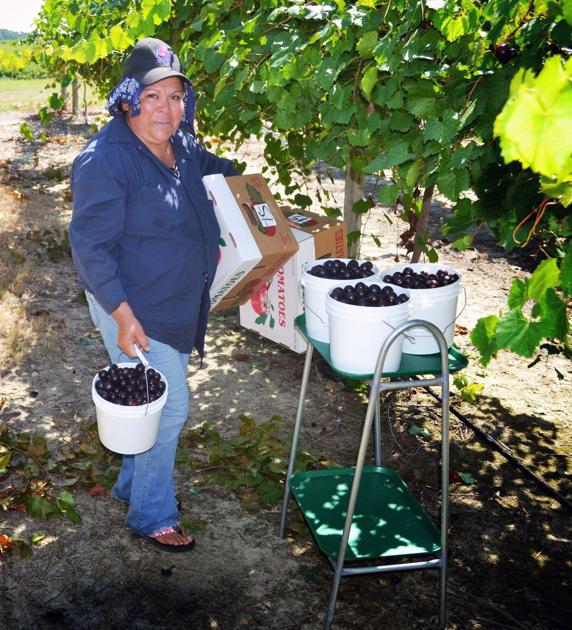
I wrote about muscadine grapes (Vitis rotundifoli) four or five years ago, but I thought it was relevant to bring them up again. Georgia Senate Bill 358 was signed by the Gov. Kemp on Aug. 5, 2020 designated the muscadine grape as the official state grape.
For those of you who are northern transplants, muscadines are native to Georgia and the southeastern United States. In fact, Georgia is the largest producer of muscadine grapes in the nation. Georgia's climate is well suited for growing these grapes which can be used for making jams, sauces and wine.
When Sir Walter Raleigh landed on the North Carolina coast in 1584 he found muscadine grapes growing wild. He described them as being "in all the world the like abundance is not to be found." The word muscadine comes from the French word “muscatel” referring to a sweet wine made from the muscat grape.
For the last 400 years farmers have worked to tame the muscadine, developing varieties such as Acarlos and Agolden Isle. These varieties still cover the backyards and home gardens of Georgia and surrounding states. They range in color from tawny bronzes to purple black.
The term muscadine currently refers to varieties that are purple or black in color. The golden colored varieties of muscadines are referred to as scuppernongs.
But make no mistake; scuppernongs are a variety of muscadine. The name scuppernong comes from the Scuppernong River in North Carolina.
Muscadines have much larger individual berries than bunch grapes, and they grow in smaller pods or clusters. They have a thicker skin and are somewhat spicy-sweet. One of the biggest differences is that muscadines are picked individually over an extended harvest period, so you would not normally find them in your local supermarket. Both muscadines and scuppernongs mature in August and early September, when you can pick and eat them fresh from the vine or make them into jelly, jam, or wine.
Muscadines are popular with home growers because they are tolerant to pests and diseases. It is one of the advantages of being native to Georgia. In the home garden, they can be grown with little or no use of pesticides.
Researchers have discovered that the skin, pulp and the seeds of muscadines are high in resveratrol. Resveratrol is the compound in red wine that lowers cholesterol and the risk of coronary artery disease.
Muscadine waste from juice processing is now used to make products like muffins, jams and granola cereal. One-half serving of unfiltered muscadine juice, one serving of muscadine jam, or one medium muscadine muffin gives the same dietary amounts of resveratrol as four fluid ounces of red wine.
Getting the vines to produce grapes is an interesting proposition with muscadines. Some vines bear perfect flowers, which contain both male and female parts. Some vines can bear imperfect flowers, which have only female organs.
A perfect-flowered vine is self-pollinating, so that it does not require another plant for successful pollination. An imperfect-flowered plant requires a perfect-flowered vine nearby to be pollinated. These perfect flowered vines are called pollinizers because they lend their pollen to the imperfect plants. In a single row with imperfect vines, every third vine should be a pollinizer.
If you want to try growing muscadines and do not have room for multiple vines, make sure you get a variety that has perfect flowers.
Muscadines are different from bunch grapes. Bunch grapes are the grapes that you find in the supermarket. Bunch grapes, or “pod” grapes, produce large clusters of fruit. They have a concentrated harvest period and the entire cluster or “bunch” of grapes is picked as a uniformly ripe intact unit.
However, bunch grapes are more susceptible to disease and insects than muscadines. They take more care and you may have to adhere to an extensive spraying schedule to produce a good crop.
Pierce's disease (Xylella fastidiosa) is the primary disease limiting production of bunch grapes. It is a bacteria-like disease spread by leafhoppers. It can limit the harvest and can even kill susceptible bunch grape varieties. Black rot and bitter rot along with the grape root borer are also problems with certain varieties of bunch grapes.
Muscadines are a delicious, healthy and easy grape to grow in your home vineyard. Just remember to plant male and female muscadines to ensure huge crops of scrumptious grapes.
For additional details or more information, you can contact us for questions about any gardening issues; contact a Master Gardener volunteer at the UGA Cooperative Extension Carroll County Office at 900 Newnan Road in Carrollton at 770-836-8546 or via email at ccmg@uga.edu.
January 26, 2021 at 05:30AM
https://ift.tt/2NqBPNx
What are muscadine grapes? | Farm and Garden | times-georgian.com - Times-Georgian
https://ift.tt/3eO3jWb
Grape

No comments:
Post a Comment